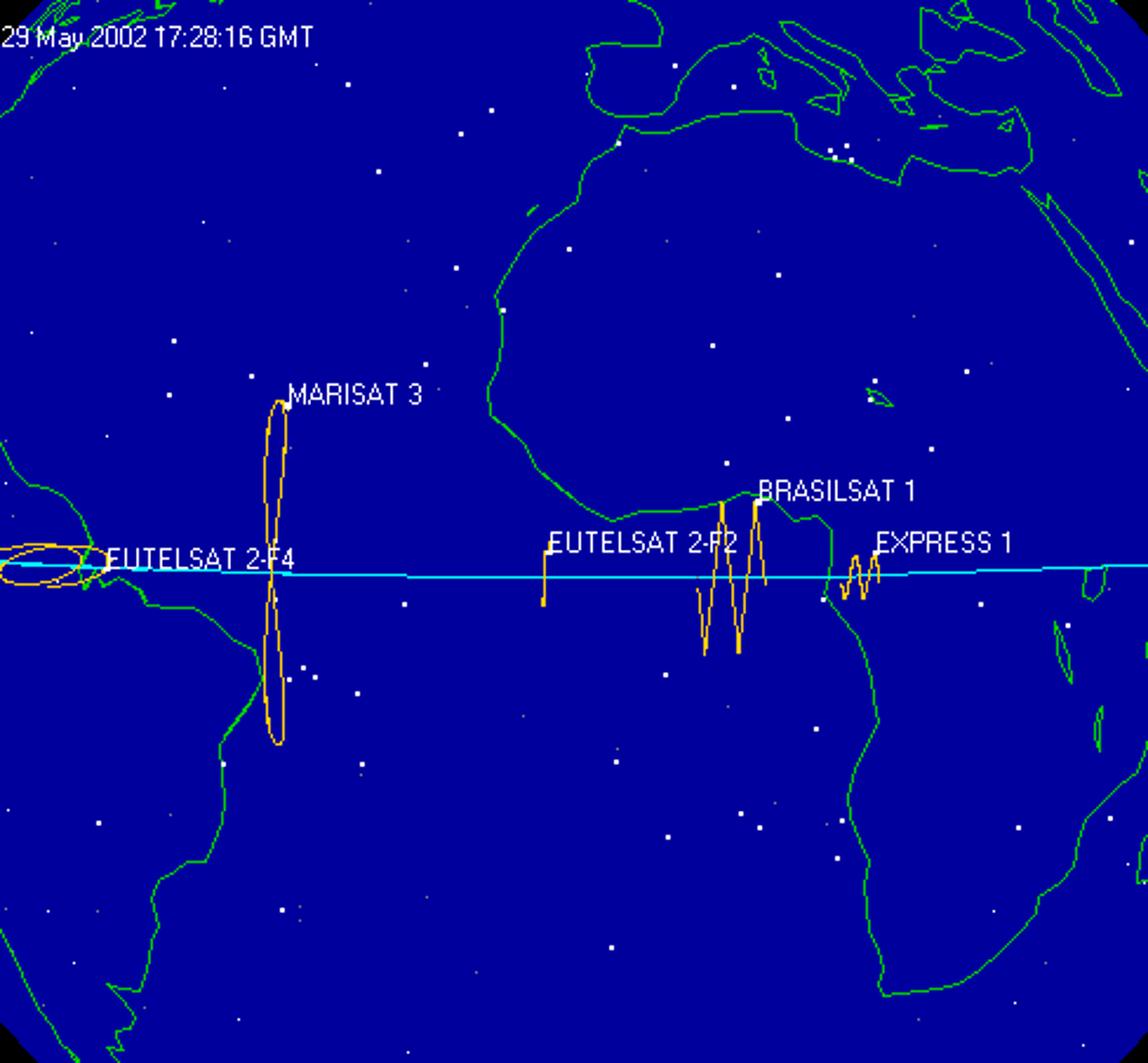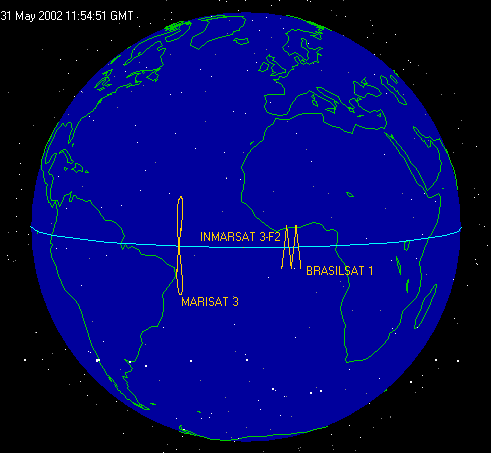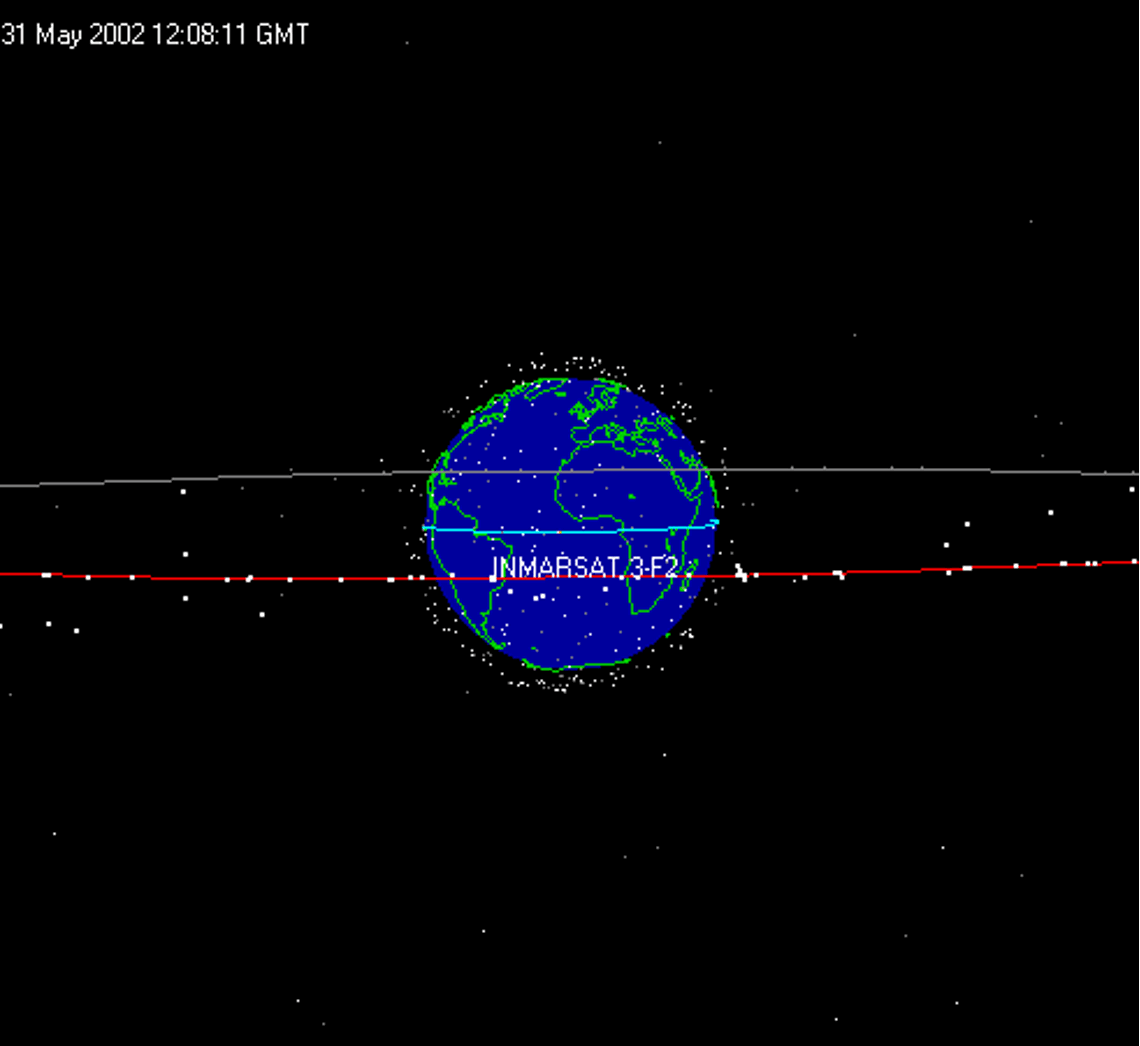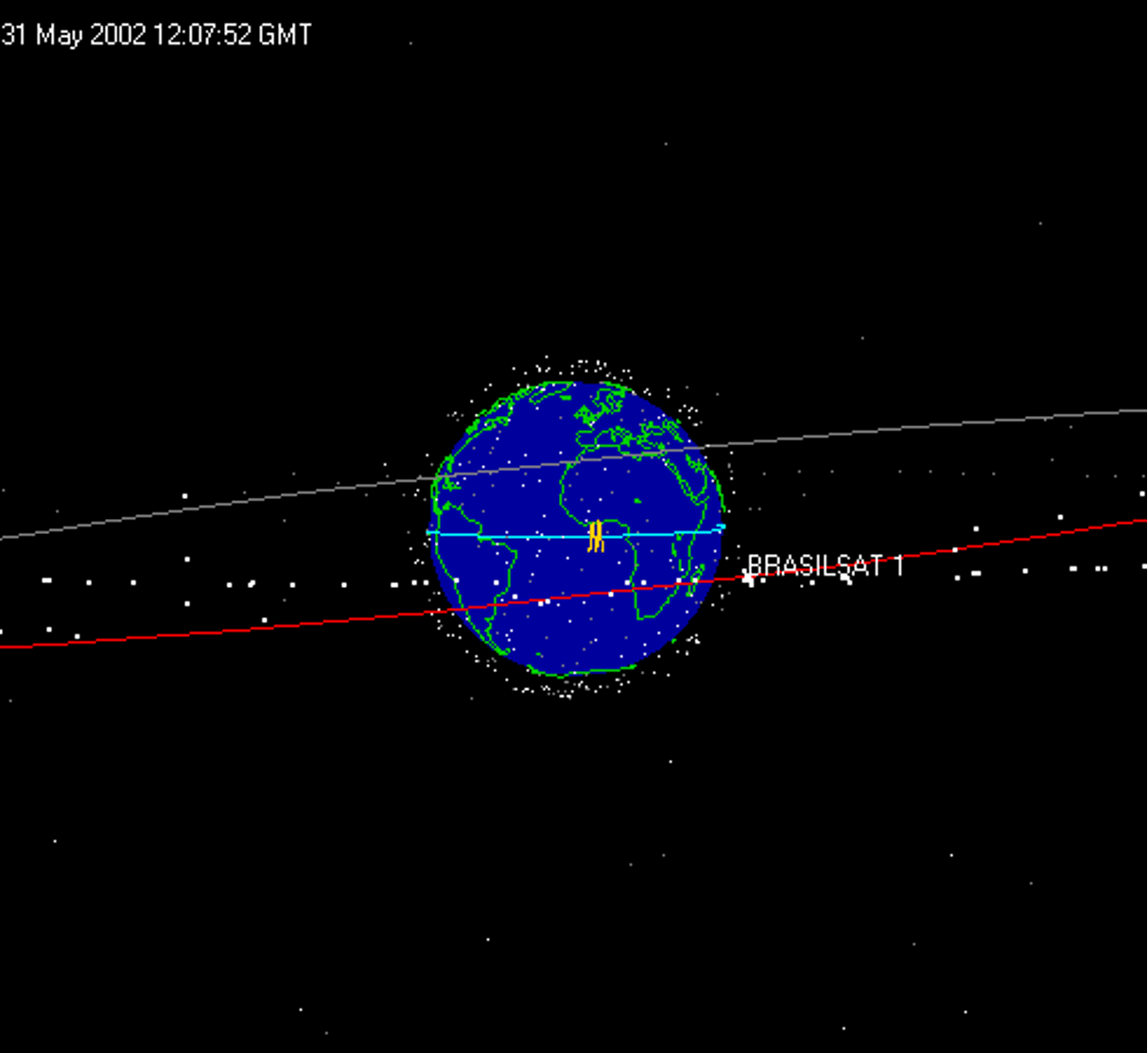


Science and Faith
Science and Faith
Catholic Outlook
Catholic Outlook

Catholic Outlook
Science and Faith
Science and Faith
__________ Recent Additions __________
Catholic Outlook
Catholic Outlook
Dialogue on Looping and
Zig-Zagging Satellites
(Part 1)
How the the apparent motion of geosynchronous
satellites proves that the earth rotates
Gary Hoge
__________ About this Dialogue __________
A dialogue with Catholic geocentrist Bob Sungenis. My words are in black, and Bob’s are in blue.
From the picture-is-worth-a-thousand-words department:

I would love to see how a geocentrist could possibly explain the daily movement of these satellites. They’re all at about the same altitude, and therefore exposed to the same forces, but we have Eutelsat 2-F4 doing a lazy rolling loop, Marisat 3 doing a graceful figure-eight, Eutelsat 2-F2 doing a slow back-and-forth, Brasilsat 1 doing a big zig-zag, and Express 1 doing a small zig-zag.
If this is merely apparent motion caused by orbital inclinations and a rotating earth, it makes sense, but I don’t see how it can possibly be actual motion of satellites over a stationary earth.
If there is oscillation and inclination in any of the satellites, in my system it would be due to the forces of oscillation and inclination produced by a rotating star system, just as you account for those oscillations and inclinations by a rotating earth.
Except that in my system, the ground track is just a visual effect, an optical illusion, caused by the fact that we’re looking at the satellites while we’re rotating along with them. The satellites don’t really move like that; they all orbit in a nearly perfect circle. Therefore, I’m not proposing that the rotation of the earth exerts a force on those satellites that causes them to move in crazy patterns.
In Robert’s world, though, the satellites aren’t orbiting, they’re actually moving around in spirals and zig-zags, and so he has to postulate an actual force that can push them around in those patterns. And his answer is that the very different motion of these very similar satellites is supposedly caused by the same force acting on each of them, though he doesn’t explain how the same force can cause such wildly different motion.
By Gary’s own words, the GSS are not really doing crazy little dances, they only appear to be doing so. He hasn’t explained how a rotating earth is going to account for that apparent motion, as opposed to a rotating star system.
I think I have, but just to be crystal clear, I will explain it again, and I will illustrate exactly how a rotating earth accounts for this motion in a way that a non-rotating earth simply can’t.
Let’s consider three satellites: Inmarsat 3-F2, Marisat 3, and Brasilsat 1. Here are their actual ground-tracks:

These satellites actually follow these paths over the ground each day. If you’re having trouble seeing the ground-track for Inmarsat 3-F2 that’s because compared to the other satellites it’s stationary. Therefore, its ground-track is just a dot on the equator. (Look underneath the second “a” in “Inmarsat”.) Now, let’s compare how the two world-views must explain this motion.
Rotating Earth
If the earth is rotating, then we can explain the motion of these satellites quite easily: They aren’t actually moving in these crazy patterns, they just appear to move that way (to a person standing on the ground) because the ground over which they’re moving is moving, too. All three satellites are really orbiting the earth in nearly perfect circles and in synch with the earth’s rotation. In that case, Inmarsat 3-F2’s orbit looks like this:

Because this satellite’s orbit is almost perfectly circular, it moves at a nearly constant velocity, in synch with the rotation of the earth. And because its orbit is almost perfectly aligned with the equator, the satellite always appears to be directly above the equator. Therefore, as this satellite orbits in synch with the earth’s rotation, it appears to hover over a single spot on the equator. That’s easy enough to understand, right?
But how, then, do we account for the figure-eight pattern traced out every day by Marisat 3? Like this:

This satellite’s orbit is significantly inclined with respect to the equator, so every day as it follows its orbital path, it goes up above the equator and then down below the equator. Because it orbits in synch with the earth’s rotation, it appears (to a person on the ground) to be moving straight up and straight down, tracing out an up-and-down line over the earth. But there’s one additional factor to consider. This satellite’s orbit isn’t perfectly circular, it’s slightly elliptical. That means that the satellite will speed up and slow down slightly as its orbit carries it slightly toward and away from the earth. But as it speeds up, it will temporarily be going faster than the earth is rotating, and it will appear to move slightly to the east relative to the ground. As it slows down, it will temporarily be going slower than the earth is rotating, and it will appear to move slightly to the west relative to the ground. Because it’s moving slightly east-and-west as it’s also moving significantly north-and-south, it traces out a perfect figure-eight over the surface of the moving earth.
Finally, Brasilsat 1’s zig-zag ground-track is caused by this orbit:

As you can see, this orbit is also significantly inclined with respect to the equator. If Brasilsat 1 were truly orbiting in synch with the earth’s rotation, it would trace out a straight line up-and-down every day. But this satellite is no longer in a truly geosynchronous orbit. It’s now orbiting slightly farther from the earth, which means it’s moving just slightly slower than the earth is rotating. Therefore, as the satellite traces out its up-and-down motion, it’s also constantly lagging behind the earth’s rotation, and therefore moving to the west relative to the ground. That’s what makes it trace out a zigzag path, like a pen on a seismograph.
So, if the earth is rotating, the motion of all three satellites relative to the ground can be easily explained. Now, let’s consider a geocentric universe.
Non-Rotating Earth
In Mr. Sungenis’ world, the earth is stationary, and therefore those three satellites aren’t orbiting the earth at all. In that case, their motion over the ground isn’t apparent, it’s actual. In other words, Inmarsat 3-F2 is just hovering over its spot on the equator, not moving much at all. Meanwhile, Marisat 3 is actually moving in a figure-eight pattern, around and around, once each day. And while Marisat 3’s going around in graceful circles, Brasilsat 1 is moving in a constant zigzag toward the east. This satellite, then, really is orbiting the earth, but it takes it a month or so to complete a single orbit.
Here’s the rather obvious problem with this scenario: If the rotating sphere of stars is exerting a force on these satellites, it’s going to be exerting the same force on all three satellites. In other words, the same force that’s acting on Marisat 3 is also acting on Inmarsat 3-F2 and Brasilsat 1. The sphere of stars isn’t rotating any differently for one satellite than it is for the other two. Therefore, however this force affects these satellites, it would effect them in the same way. If it acts to pull them toward the east, then all three should be pulled toward the east; if it acts to make them go in a giant figure-eight, then all three should go in a giant figure-eight. There’s simply no way to account for the radically different motion of these three satellites that are all under the influence of exactly the same forces. To claim otherwise, as Mr. Sungenis does, would be like placing three tennis balls on the same ramp and expecting one of them to roll down the ramp in a zigzag pattern, the second one stand still, and the third one roll around in a figure-eight. It’s simply not possible.
Consider: In order to make a satellite actually move in a figure-eight, like Marisat 3, you’d have to have a force that’s constantly changing the direction from which it pulls the satellite. If you imagine the satellite floating in space and being pulled along behind a huge magnet that was tracing out a figure-eight you’ll see what I’m talking about. There has to be some actual force that exerts a constantly shifting pull on the satellite (while, of course, also suspending it above the earth) in order to make it move like that. But Inmarsat 3-F2, which is exposed to exactly the same forces from the stars that Marisat 3 is exposed to doesn’t move at all. And of course, a completely different set of forces would be required to move Brasilsat 1 in the path it’s following. In fact, while the “force from the stars” is busy pulling Brasilsat 1 constantly toward the east, it’s also pushing Marisat 3 toward the west half of the time, and pulling it toward the east the other half of the time.
Obviously, this is not possible, and that’s why Mr. Sungenis’ following comment makes no sense:
He’s just assumed that a rotating star system is somehow different than a rotating earth. But I’ve shown him at least a dozen times already, based on Einstein’s own equations, that there is no difference. Each motion, or non-motion, he attributes to a rotating earth can be attributed to a rotating star system. There is no difference.
In terms of the stars, he might be right. The stars appear to move around the earth in a perfect circle, and there’s no way to tell just by looking whether that motion is caused by a spinning earth or by rotating stars. But that is not the case when we consider geosynchronous satellites. You can’t just flip things around and claim there’s no difference. I’ve clearly explained how the motion of these three satellites is accounted for in a rotating-earth system. They’re moving in more or less circular and more or less inclined orbits around a rotating earth and their motion over the ground is simply what you get when you combine these two motions. But their motion over the ground simply cannot be accounted for in a non-rotating earth system, because in that case we have to say that they really are moving in crazy patterns over a motionless earth. Mr. Sungenis simply cannot explain how the same force, operating on nearly identical satellites, at approximately the same altitude causes those satellites to move in radically different ways (or, in the case of Inmarsat 3-F2, not to move at all).
Part 1, Part 2, Part 3, Part 4, Part 5
Copyright © 2024 Catholicoutlook.me
MENU